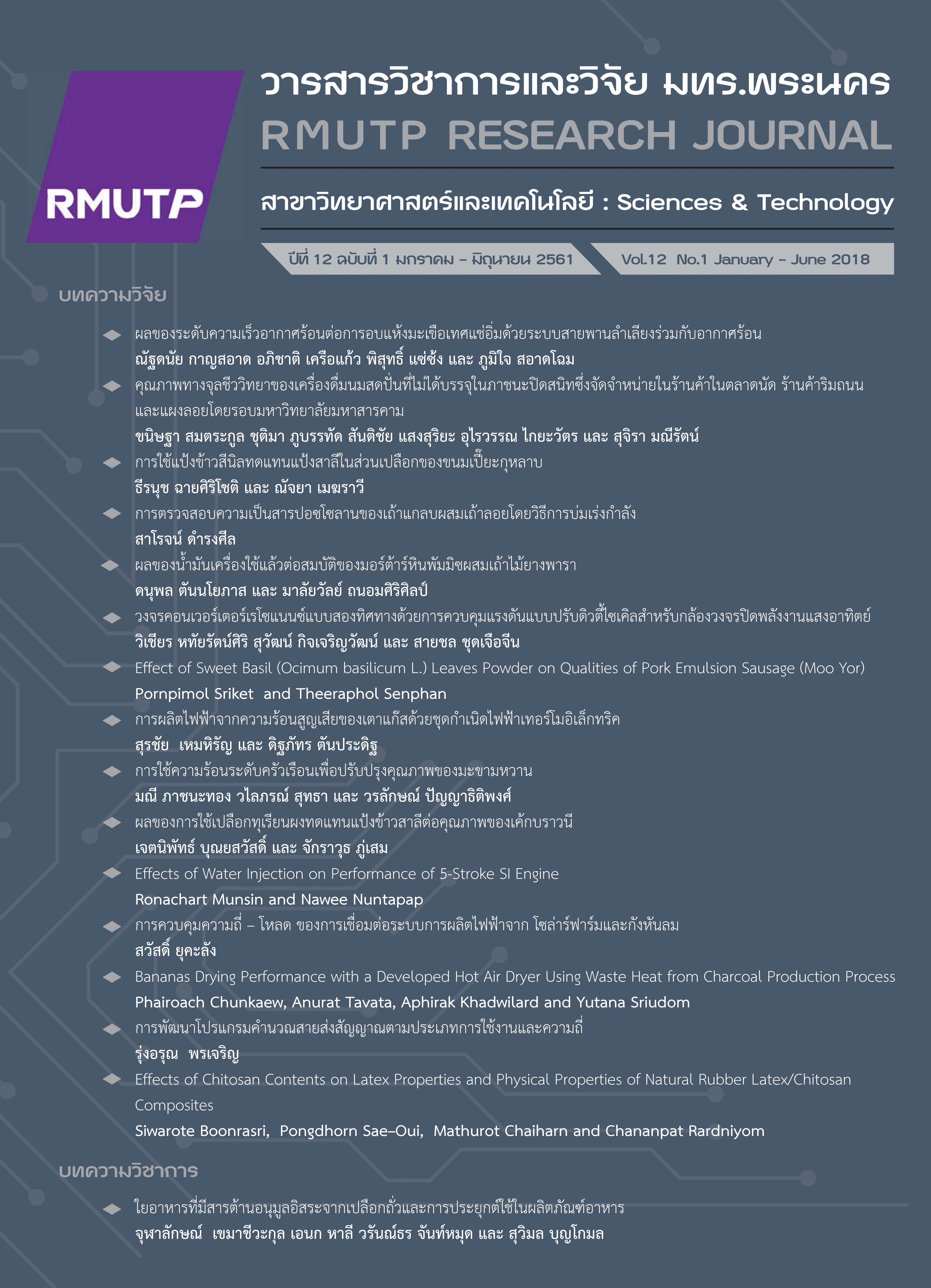ผลของน้ำมันเครื่องใช้แล้วต่อสมบัติของมอร์ต้าร์หินพัมมิซผสมเถ้าไม้ยางพารา
Main Article Content
บทคัดย่อ
งานวิจัยนี้ศึกษาสมบัติมอร์ต้าร์มวลรวมพัมมิซผสมเถ้าไม้ยางพาราในอัตราส่วนที่ต่างกันร้อยละ 0, 20 และ 40 ของน้ำหนักปูนซีเมนต์ปอร์ตแลนด์ ประเภท 1 ผสมน้ำมันเครื่องใช้แล้วในอัตราส่วนร้อยละ 0, 0.2 และ 0.3 ของปริมาณน้ำ ตัวอย่างทดสอบทุกสูตรหล่อเป็นทรงลูกบาศก์ให้มีขนาด 5x5x5 เซนติเมตร บ่มในอากาศเป็นเวลา 7 และ 28 วัน การทดสอบประกอบด้วย การดูดซึมน้ำ ความหนาแน่น ความต้านทานไฟฟ้าจำเพาะ ความแข็งแบบชอร์ และกำลังอัด และวิเคราะห์ภาพถ่ายจุลทรรศน์อิเล็กตรอนแบบส่องกราด พบว่าอายุบ่มช่วยพัฒนาสมบัติของตัวอย่าง เช่น ความต้านทานไฟฟ้าจำเพาะ ความแข็ง และกำลังอัด ตัวอย่างสูตรผสมเถ้าไม้ยางพาราร้อยละ 20 และน้ำมันเครื่องใช้แล้วร้อยละ 0.2 บ่ม 28 วัน ให้ค่าความหนาแน่น 1.61 กรัม/ลูกบาศก์เซนติเมตร และกำลังอัดสูงสุด 22.09 เมกกะปาสคาล
Article Details

อนุญาตภายใต้เงื่อนไข Creative Commons Attribution-NonCommercial-NoDerivatives 4.0 International License.
ลิขสิทธ์ ของมหาวิทยาลัยเทคโนโลยีราชมงคลพระนครเอกสารอ้างอิง
M. El-Fadel and R. Khoury, “Strategies for vehicles waste-oil management; a case study,” Resources, Conservation and Recycling, vol. 33. no. 2, pp. 75-91, Sept. 2001.
S. Beddu, M. F. Nuruddin, and N. Shafiq, “Effect of used engine oil as chemical admixtures on the properties of high strength concrete,” ICCBT 2008 – A., vol. 16, pp. 185-190, 2008.
Pollution Control Department, “Hazardous waste is near than think,” Office of Waste and Hazardous Substances Management. [Online] Available http://www.pcd.go.th/Info_serv/haz_lubri.html. Accessed on May 5, 2016
Foam concrete, Thailand Industrial Standards Institute TIS. 2601, 2013.
S. Mindess, J. F. Young and D. Darwin, Concrete, 2nd ed. Prentice Hall, Pearson Education, Inc., 2003.
S. S. Hussen, “Using of industrial waste as a green chemical admixture in concrete,” Kufa Journal of Engineering, vol. 7, no. 1, pp. 104-114, Jan. 2016.
B. S. Hamad, A. Rteil, and M. El-Fadel, “Effect of used engine oil on properties of fresh and hardened concrete,” Construc-tion and Building Materials, vol. 17, no. 5, pp. 311-318, 2003.
S. C. Chin, Shafiq N. and M. F. Nuruddin “Structural performance of reinforced concrete beams containing used engine oil,” vol. 38, no. 1-2, pp. 1-23, 2010.
B. S. Hamad and A. A. Rtei, “Effect of used engine oil on structural behavior of reinforced concrete elements,” Construc-tion and Building Materials, vol. 17, no. 3, pp. 203–211, 2003.
S. C. Chin, N. Shafiq and M. F. Nuruddin, “Effects of used engine oil in reinforced concrete beams: The structural behavior,” International Journal of Civil, Environmental, Structural, Construction and Architectural Engineering, vol. 6, no. 3, pp. 254-260, 2012.
M. N. Hussein, “Properties of concrete containing new and used engines oil,” International Journal of Science and Research, vol. 4, no. 12, pp. 268-272, Dec. 2015.
N. Shafiq, M. F. Nuruddin and S. Beddu, “Properties of concrete containing used engine oil,” International Journal of Sustainable Construction Engineering & Technology, vol. 2, no. 1, pp. 72-82, June 2011.
J. J. Assaad, “Disposing used engine oils in concrete-optimum dosage and compatibility with water reducers,” Construction and Building Materials, vol. 44. no. 7, pp. 734-742, Jul. 2013.
G. E. Abdelaziz, “Utilization of used engine oil in concrete as a chemical admixture,” Engineering Sciences and Information Technology, 2003.
S. Beddu, N. Shafiq, M. F. Nuruddin, N. L. M. Kamal and S. N. Sadon, “Effects of used engine oil as an admixture in concrete durability,” British Journal of Applied Science & Technology, vol. 15. no. 6, pp. 1-10, 2016.
O. B. Elah and G. Amode, “Effect of used engine oil on some properties of cement and laterized concrete,” American Journal of Civil and Structural Engineering, vol. 2, no. 1, pp. 7-10, 2015.
H. Diab, “Compressive strength performance of low- and high-strength concrete soaked in mineral oil,” Construction and Building Materials, vol. 33, pp. 25–31, Feb. 2012.
D. Tonnayopas. (2553). Minerals and Rocks, 1st ed., Prince of Songkla University, 2010.
D. Tonnayopas and W. Wannasopha, “Assessment and effect of pumice aggregate on the properties of concrete masonry unit,” in Proceeding of 8th National Convention on Civil Engineering, Khon Kaen, Thailand, 2002, pp. MAT-18 to MAT-23.
D. Tonnayopas and S. Outtrachon, “Influence of oil palm fuel ash on properties of pumice lightweight aggregate concrete,” in Proceeding of 6th PSU Engineering Conf. (PEC6), Prince of Songkla University, Thailand, 2008, pp. 13-18.
A. Hawa and D. Tonnayopas, “Effect of rubber wood fly ash on properties of pumice aggregate concrete,” in Proceeding of 6th PSU Engineering Conf. (PEC6), Prince of Songkla University Thailand, 2008, pp. 43-48.
D. Tonnayops and P. Penthong, “Properties of concrete containing natural rubber latex dipped pumice aggregate and slate powder,” Rajamangala University of Technology Tawan-Ok (RMUTTO) Research Journal, vol. 7, no. 1, pp. 73-80, 2014.
U. Buangam, J. Manit, S. Chantaramanee, and D. Tonnayopas, “Properties of coir fiber reinforced pumice cement composite mixed oil palm ash,” The Journal of Applied Science, vol. 13, no. 2, pp. 76-92, 2014.
D. Tonnayopas and J. Yiamyokkun, “Pumice powder and rubber sawdust ash as cement additives on the physical and mechanical characteristics,” in Proceeding of 4th PSU Engineering Conf. (PEC4), Prince of Songkla University, Thailand, 2005, pp. MnE-7 – MnE-12.
D. Tonnayopas and J. Chaosincharoen, “Mortar containing fly ash and rubber sawdust ash,” Songklanakarin Journal of Science and Technology, vol. 22, no. 4, pp. 489–500, 2000.
J. J. Assaad, J. Harb and E. Chakar, “Relationships between key ASTM test methods determined on concrete and concrete-equivalent-mortar mixtures,” Journal of ASTM International, vol. 6, no. 3, pp. 1-13, 2009.
Standard test method for density (unit weight), yield, and air content (Gravimetric) of concrete, ASTM C 138/C 138M–01a, 2001.
Testing concrete. Method for determination of compressive strength of concrete cubes, BS 1881: part 116, 1983.
Standard specifi-cation for lightweight aggregates for structural concrete, ASTM C330/C330M-14, 2014.
J. Havlica, “Mechanism of ettringite and monosulphate formation,” Cement and Concrete Research, vol. 22, no. 4, pp. 671-677, July 1992.


